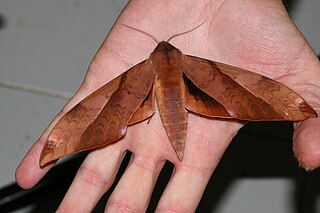
Psilogramma menephron, the privet hawk moth or large brown hawkmoth, is a member of the family Sphingidae. It was described by Pieter Cramer in 1780. It is usually found in Sri Lanka, India, Nepal, central and southern China, Thailand, Vietnam, Indonesia and the Philippines. Psilogramma casuarinae from eastern Australia was long treated as a synonym but is now thought to be a distinct species. The introduced population on Hawaii was first thought to be P. menephron, but is Psilogramma increta.

Cechenena helops is a moth of the family Sphingidae first described by Francis Walker in 1856. It is found in Malaysia, Indonesia, the Philippines, Nepal, north-eastern India, Thailand, south-western China and Vietnam.

Theretra clotho, the common hunter hawkmoth, is a moth of the family Sphingidae. It is found from Sri Lanka, India, Nepal and Myanmar, east through China to Taiwan, South Korea and Japan, and then south-east through South East Asia as far as the Lesser Sunda Islands and Timor in Indonesia. They can disperse long distances and may be found up to northern China. The habitat consists of open forests, forest edges, orchards, plantations, wooded scrubs, suburban gardens and city parks.

Theretra silhetensis, the brown-banded hunter hawkmoth, is a moth of the family Sphingidae described by Francis Walker in 1856. It lives in Indo-Australia, India, Sri Lanka, Papua New Guinea, East Australia, Solomon Islands, Fiji Islands, Vanuatu Islands.

Callambulyx rubricosa, the large pink-and-green hawkmoth, is a species of moth of the family Sphingidae first described by Francis Walker in 1856.

Hippotion rosetta, or Swinhoe's striated hawkmoth, is a sphingid moth of the family Sphingidae. The species was first described by Charles Swinhoe in 1892.

Phyllosphingia is a monotypic moth genus in the family Sphingidae erected by Charles Swinhoe in 1897. Its only species, Phyllosphingia dissimilis, the buff-leaf hawkmoth, was described by Otto Vasilievich Bremer in 1861.

Pergesa is a monotypic moth genus in the family Sphingidae first described by Francis Walker in 1856. Its only species, Pergesa acteus, the green pergesa hawkmoth, was described by Pieter Cramer in 1779.

Ambulyx moorei, the cinnamon gliding hawkmoth, is a moth of the family Sphingidae. The species was first described by Frederic Moore in 1858. It is found in Sri Lanka, southern and eastern India, the Nicobar Islands and Andaman Islands, Thailand, Vietnam, southern China, the Philippines, Malaysia, Singapore and Indonesia.

Clanis undulosa, the wavy velvet hawkmoth, is a moth of the family Sphingidae first described by Frederic Moore in 1879. The nominate subspecies is found in the southern Russian Far East, the Korean Peninsula and north-eastern China, as far as south and west as Shaanxi and Hebei. South from Sichuan (Baoxing), Hubei, Jiangxi (Guling) and Zhejiang, it is replaced by ssp. gigantea, which ranges west to Nepal and south, through Thailand and Vietnam, to Peninsular Malaysia.

Daphnusa ocellaris, the durian hawkmoth, is a species of moth of the family Sphingidae.

Langia zenzeroides, the apple hawkmoth, is a moth of the family Sphingidae. It was described by Frederic Moore in 1872.

Ampelophaga rubiginosa is a moth of the family Sphingidae. It was described by Otto Vasilievich Bremer and William (Vasilii) Grey in 1853. It is found from north-eastern Afghanistan, east around the southern margin of the Himalaya to Yunnan, then throughout China to the Russian Far East, the Korean Peninsula and Japan. It is also found south through Thailand and Vietnam to Sumatra and Peninsular Malaysia.

Theretra pallicosta, the white-edged hunter hawkmoth, is a moth of the family Sphingidae described by Francis Walker in 1856. It is found from Sri Lanka and India, east through Nepal, Bangladesh and Myanmar to Hong Kong and Taiwan and south through Thailand, Laos and Vietnam to Peninsular Malaysia and Indonesia.

Meganoton analis, the grey double-bristled hawkmoth, is a moth of the family Sphingidae. It is known from India, Nepal, southern and eastern China, northern Thailand, northern Vietnam, Peninsular Malaysia, Indonesia, Taiwan, the southern part of the Russian Far East, South Korea and Japan.

Meganoton nyctiphanes, the dull double-bristled hawkmoth, is a moth of the family Sphingidae.

Sataspes tagalica, the brilliant carpenter-bee hawkmoth, is a species of moth of the family Sphingidae first described by Jean Baptiste Boisduval in 1875.

Marumba spectabilis, the rosey swirled hawkmoth, is a moth of the family Sphingidae. The species was first described by Arthur Gardiner Butler in 1875.

Marumba sperchius is a species of moth of the family Sphingidae first described by Édouard Ménétries in 1857.

Ambulyx sericeipennis, the common gliding hawkmoth, is a species of moth of the family Sphingidae first described by Arthur Gardiner Butler in 1875. It is found from northern Pakistan and northern India eastwards across Nepal, Sikkim, Bhutan, Myanmar, Thailand, Laos, Cambodia and Vietnam to central and southern China and Taiwan.
























